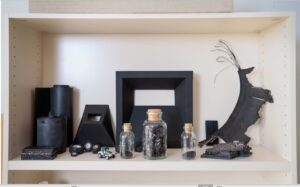CU Denver Grads Turn Tires Into Sustainable Tiles
Recently, Olivia Collier and Maslin Mellick, both 2022 master of architecture graduates at Colorado University (CU) Denver took home the Colorado Green Building Guild (CGBG) Student Project of the Year for the work they did in a studio class led by Professor of Architecture Julee Herdt.
The class was tasked with creating a “Clean-Tech Manufacturing Facility for Sustainable Building Products.” This meant they were not only going to invent a material but also design a physical place to make it.
“We didn’t know we were going to focus on tires at first,” Mellick said. “We were researching nature’s byproducts, society’s waste, and how we could use that to elevate our architecture and our inventions.”
Both agree that they wanted to work on a project with a meaningful impact on the area. So they decided to look for beauty and inspiration in the grit and dirt of landfills. “Jokingly, our team’s name was Junk Girls,” Collier said.
 “We were doing a lot of hands-on research in trash.” It just so happened that they didn’t need to look far to find inspiration at the Colorado Tire Recycling (CTR), which is located in Commerce City. In talking with CTR’s manager, they learned that about 80 million used tires currently reside nearby in Hudson at a tire monofill known as “Tire Mountain.”
“We were doing a lot of hands-on research in trash.” It just so happened that they didn’t need to look far to find inspiration at the Colorado Tire Recycling (CTR), which is located in Commerce City. In talking with CTR’s manager, they learned that about 80 million used tires currently reside nearby in Hudson at a tire monofill known as “Tire Mountain.”
After researching the topic, the team realized there was work to be done in two major areas. The first: advocating for policy change involving tire waste. The second: incentivizing another end-market use for the tires. Their solution—which involves devulcanization, a process of recycling rubber by breaking down the toxins and sulfur components—creates a new building material with all the positive properties of rubber without the toxic off-gassing.
“Tire Tiles,” would come in two styles: “Solid” and “Void.” Solid could be used in colder climates for wall assembly that would provide thermal, waterproofing, and acoustic benefits. Void, which includes gaps and spaces, would be used in warmer climates, for breathable wall assembly and solar shading.
Ultimately, using the tiles would decrease the number of materials needed for building. “A lot of cost from architecture comes from all the layers that go into a wall,” Mellick said. “So, by having this product that covers a lot of ground, it’s cost-efficient.”
Aside from the physical properties of the tires, Collier and Mellick wanted to design something that would be aesthetically pleasing. They hope that because the tiles would be on the exteriors of buildings, they would inspire curiosity and help educate the public about the potential of a closed loop for not just tires, but waste management.
“Recycling waste tires is so much bigger than just our project,” Collier said. “It could be utilized in so many ways in the building industry, specifically for architecture where there are already a lot of existing uses and rubber in buildings.”
Herdt encouraged Collier and Mellick to submit their tile and manufacturing facility design to CGBG. Earlier this year, they attended an awards ceremony where they networked with industry professionals and educated their peers. “I feel really proud of what we developed,” Mellick said. “It’s exciting to see that our work is inspiring other people and that’s really rewarding.”
Although the semester came to an end, their degrees have already started paying off: both are currently working in their field as architectural designers. Collier and Mellick agree that their work isn’t quite complete when it comes to tires.
Through their research, Collier and Mellick have found a passion for advocacy, which they plan to continue. They hope to contribute to closing the loop on tires by meeting with experts to inform safer and healthier uses that might inspire new markets for them. “The more tires we can deviate from the monofills, the better.”
Source:
Kristin Goosen, University Communications
© Scrap Tire News, June 2023






